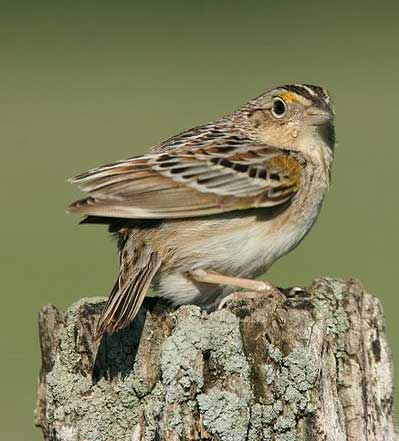
Ammodramus savannarum (*)
Superregnum: Eukaryota
Cladus: Unikonta
Cladus: Opisthokonta
Cladus: Holozoa
Regnum: Animalia
Subregnum: Eumetazoa
Cladus: Bilateria
Cladus: Nephrozoa
Superphylum: Deuterostomia
Phylum: Chordata
Subphylum: Vertebrata
Infraphylum: Gnathostomata
Megaclassis: Osteichthyes
Cladus: Sarcopterygii
Cladus: Rhipidistia
Cladus: Tetrapodomorpha
Cladus: Eotetrapodiformes
Cladus: Elpistostegalia
Superclassis: Tetrapoda
Cladus: Reptiliomorpha
Cladus: Amniota
Classis: Reptilia
Cladus: Eureptilia
Cladus: Romeriida
Subclassis: Diapsida
Cladus: Sauria
Infraclassis: Archosauromorpha
Cladus: Crurotarsi
Divisio: Archosauria
Cladus: Avemetatarsalia
Cladus: Ornithodira
Subtaxon: Dinosauromorpha
Cladus: Dinosauriformes
Cladus: Dracohors
Cladus: Dinosauria
Ordo: Saurischia
Cladus: Eusaurischia
Subordo: Theropoda
Cladus: Neotheropoda
Cladus: Averostra
Cladus: Tetanurae
Cladus: Avetheropoda
Cladus: Coelurosauria
Cladus: Tyrannoraptora
Cladus: Maniraptoromorpha
Cladus: Maniraptoriformes
Cladus: Maniraptora
Cladus: Pennaraptora
Cladus: Paraves
Cladus: Eumaniraptora
Cladus: Avialae
Infraclassis: Aves
Cladus: Euavialae
Cladus: Avebrevicauda
Cladus: Pygostylia
Cladus: Ornithothoraces
Cladus: Ornithuromorpha
Cladus: Carinatae
Parvclassis: Neornithes
Cohors: Neognathae
Cladus: Neoaves
Cladus: Telluraves
Cladus: Australaves
Ordo: Passeriformes
Subordo: Passeri
Infraordo: Passerida
Superfamilia: Passeroidea
Familia: Passerellidae
Genus: Ammodramus
Species: Ammodramus savannarum
Subspecies: A. s. ammolegus – A. s. beatriceae – A. s. bimaculatus – A. s. borinquensis – A. s. caribaeus – A. s. caucae – A. s. cracens – A. s. floridanus – A. s. intricatus – A. s. perpallidus – A. s. pratensis – A. s. savannarum
Name
Ammodramus savannarum (Gmelin, 1789)
Type locality: Jamaica.
Synonyms
Fringilla savannarum (protonym)
Coturniculus savannarum (Gmelin, 1789)
Fringilla passerina Wilson, 1811
References
Gmelin, J.F. 1789. Caroli a Linné systema naturae per regna tria naturae, secundum classes, ordines, genera, species, cum characteribus, differentiis, synonymis, locis. Tomus I, Pars II. Editio decima tertia, aucta, reformata. - pp. 501–1032. Lipsiae. (Beer). DOI: 10.5962/bhl.title.545 p. 921 BHL Reference page.
Vernacular names
čeština: strnadec pustinný
dansk: Græshoppespurv
Deutsch: Heuschreckenammer
English: Grasshopper Sparrow
español: Chingolo saltamontes
eesti: heinasidrik
suomi: heinäsirkkunen
français: Bruant sauterelle
Kreyòl ayisyen: Zwazo Kann
magyar: szöcske verébsármány
italiano: Passero locustella
日本語: イナゴヒメドリ, inagohimedori
lietuvių: Vikrusis žvirblelis
Nederlands: Sprinkhaangors
norsk: Gresshoppespurv
polski: bagiennik preriowy
português: Escrevedeira-dos-gafanhotos
русский: Кузнечиковая саванная овсянка
slovenčina: strnádlik savanový
svenska: Gräshoppsparv
中文: 黄胸草鹀
The grasshopper sparrow (Ammodramus savannarum) is a small New World sparrow. The genus Ammodramus contains nine species that inhabit grasslands and prairies.
The Florida grasshopper sparrow (Ammodramus savannarum floridanus) is endangered.
Description
These small sparrows measure 10–14 cm (3.9–5.5 in) in length, span about 17.5 cm (6.9 in) across the wings and weigh from 13.8 to 28.4 g (0.49 to 1.00 oz), with an average of 17 g (0.60 oz).[2][3] Adults have upperparts streaked with brown, grey, black and white; they have a light brown breast, a white belly and a short brown tail. Their face is light brown with an eye ring and a dark brown crown with a central narrow light stripe. There are regional variations in the appearance of this bird.
Distribution and habitat
Their breeding habitat is open fields and prairie across southern Canada, the United States, Mexico and Central America, with a small endangered population in the Andes of Colombia and (perhaps only formerly) Ecuador. The northern populations migrate to the southern United States, Mexico, Central America and the Caribbean. Like many grassland birds, this bird's numbers have declined across many parts of its range, including a 98% drop in New York State.
Behaviour
The nest is a well-concealed open cup on the ground under vegetation. They forage on the ground in vegetation, mainly eating insects, especially grasshoppers, and seeds.
Song
Call
This bird's song is a buzzy tik tuk zee, resembling the sound made by a grasshopper. Unlike some other members of the Ammodramus genus of sparrows, they will readily sing from open and exposed perches.
References
BirdLife International (2018). "Ammodramus savannarum". IUCN Red List of Threatened Species. 2018: e.T22721144A132007482. doi:10.2305/IUCN.UK.2018-2.RLTS.T22721144A132007482.en. Retrieved 11 November 2021.
"Grasshopper Sparrow Fact Sheet". New York State Department of Environmental Conservation.
Dunning Jr., John B., ed. (1992). CRC Handbook of Avian Body Masses. CRC Press. ISBN 978-0849342585.
Retrieved from "http://en.wikipedia.org/"
All text is available under the terms of the GNU Free Documentation License

